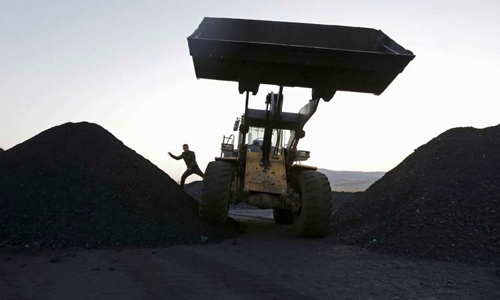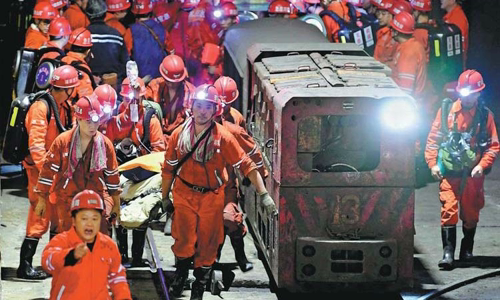The increase in coal demand has left China "short of breath" in its efforts to restrict the fuel, leading to accidents and environmental impacts.
Coal consumption in China, the world's largest carbon emitter, is on the rise again despite the government's commitment to cut back. After falling from 2.86 billion tons in 2015 to 2.76 billion tons in 2016, coal consumption in China continued to increase in the following years, expected to reach 2.85 billion tons by the end of this year and 2.89 billion tons by 2020, according to the International Energy Agency.

A coal storage site is located on the outskirts of Kexi City, Heilongjiang Province, China Photo: Reuters
In his October speech at a meeting of the National Energy Commission, Chinese Prime Minister Li Keqiang called for the development of the coal industry to ensure energy security. This is said to be a move to withdraw from Beijing's previous commitments.
Analysts said measures to boost the economy through infrastructure investment, in order to offset the impact of the prolonged trade war with the US, were one of the reasons to stimulate coal consumption in China. Coal demand increased by 7% and 11% in metal and chemicals respectively, according to the Center for Energy and Clean Air Research. The use of coal to produce cement and glass has also increased.
In addition, China is also building more coal-fired power plants with a total expected capacity of up to 148 gigawatts, nearly the whole of the European Union's coal power capacity, according to the Global Energy Monitoring Group. , a non-governmental organization in the US.
"China is extremely sincere in its declaration of becoming a leading country in combating climate change. But now the domestic situation has changed, making this effort more difficult," said Lauri Myllyvirta analyzed at the Research Center for Clean Energy and Air, commented.
Erica Downs, a scholar at Columbia University's Center for Global Energy Policy, said the US-China trade war prompted the two countries to pursue energy autonomy. Beijing is forced to rely on coal, the fuel available, as other energy sources are highly dependent on foreign countries.
China's dependence on imported oil last year reached 72%, the highest level in 50 years, according to data from energy company BP, which mostly comes from Saudi Arabia.
Demand for imported Saudi oil is increasing as other sources such as Iran and Venezuela are tightened by US sanctions. The volume of Chinese oil imported from the US itself is also reduced due to the impact of the trade war. However, the September attack of two Saudi oil plants is believed to have prompted China to increase energy autonomy.
China is also expected to become the world's largest natural gas importer by 2020 in an effort to switch fuel sources to reduce pollution. A new gas pipeline called the Siberian Power connecting with Russia is expected to partly solve energy security for China. However, this project is difficult to meet the demand, especially in the first year of operation.
Fossil fuels like coal, gasoline and natural gas release carbon dioxide into the atmosphere, causing temperatures to rise and climate change, of which coal is the biggest "culprit." Therefore, China's "coal thirst" is thought to be one of the causes of exacerbation of global warming.
Observers say China's carbon emissions have begun to rise again in the past three years. This trend is reflected in the first half of this year, when the country's carbon emissions from fossil fuels and concrete production increased by 4% over the same period last year, according to Myllyvirta's analysis based on key figures. Chinese government.

Rescuers rescued miners trapped in flooded coal mines in Yibin City, Sichuan Province on December 14 Photo: China Daily.
This situation caused Beijing to be criticized at the United Nations Climate Change Conference in Spain earlier this month. In response, China and other developing economies argue that developed countries need to provide additional funds to help them move to cleaner energy. According to Beijing, the implementation of the Paris Agreement and climate change measures need the cooperation of the whole world. However, the conference ended without any agreement.
The soaring demand for coal also makes China pay for the lives of miners. Wang Dan, an analyst at the Beijing-based Economic Intelligence Agency (EIU), said coal production in China was significantly restricted after the government implemented industrial reforms in 2015. Coal production fell from 3.97 billion tons in 2013, the highest in history, to 3.41 billion tons in 2016.
However, the rising demand for coal has stimulated production to rise again since 2017. Last year, China's coal output reached 3.68 billion tons and was up 4.5% as of November this year, according to the Bureau. China National Statistics.
Observers fear this development makes the accident more likely, because coal mines that have not been used for months or years suddenly reopen are risky, but operators often abandon them. by. Cheng Wuyi, a professor at China Geological University in Beijing, said local executives wanted to increase productivity, but the technology lagged behind, threatening the safety of miners.
14 miners were killed in a coal mine explosion in An Long district, Guizhou province on December 17. Three days earlier, four people were killed by a coal mine in neighboring Sichuan province. According to the China National Coal Mine Safety Supervision Bureau, four weeks before the explosion in Guizhou, four other coal mine accidents also left 43 people dead.
Although the number of deaths from mine accidents in China has decreased significantly compared to the early 2000s, hundreds of miners die every year. There are no statistics of accidents and casualties this year, but the figures so far show that the number of incidents has increased in the second half of the year.
After a series of recent incidents, officials have acknowledged that operators are putting profits above workers' safety. The Guanglong coal mine operating unit, where the explosion occurred in Guizhou province, did not report the accident for the required time period. According to the Chinese Ministry of Emergency Management, the province has also been in the top two consecutive years in the number of coal mine-related deaths, with 56 deaths since the beginning of the year and 49 deaths last year.
Despite many efforts to modernize production, labor safety agencies over the years have struggled to ensure local miners comply with safety standards.
In addition, the tracking of accidents is also difficult due to incomplete records. "China's data has only the total number of accidents, without specifying the severity or the party responsible. Therefore, it is difficult to determine the true cause," said Professor Nie Huihua of Renmin University. Chinese people said.



 AmmarRaza
AmmarRaza







